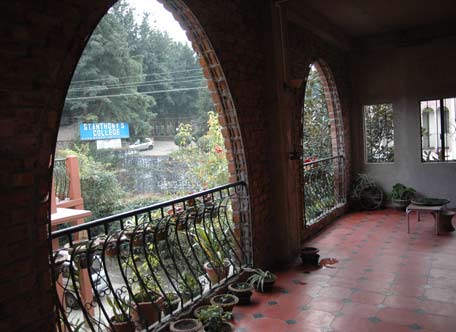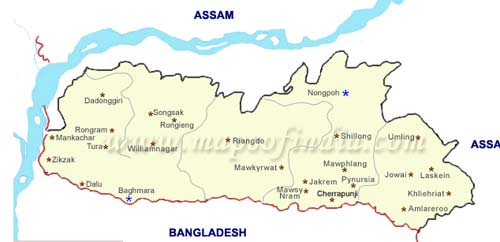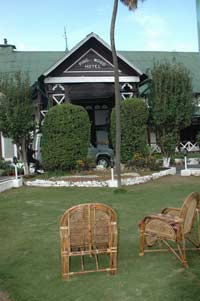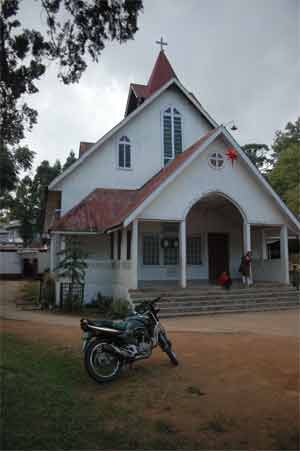SWEDISH SOUTH ASIAN STUDIES NETWORK
‘The Scotland of the East’. Shillong, Meghalaya,
25 November 2005
Land of coal, potatoes and peace
 Meghalaya
is a small Indian state, thinly populated with just about 1.3 million
population, scattered over a largely low-lying mountain area. Due to the
climate, almost all tropical fruits and crops can grow everywhere but
the plots are small, often on terraces climbing the hills. Potatoes are
grown in many areas in considerable quantities and some of it is exported.
Agriculture is also the main source of livelihood of the people, but in
certain parts small-scale coal mining gives substantial income. These
mines are mostly worked by people of Nepalese origin, that came here generations
ago.
Meghalaya
is a small Indian state, thinly populated with just about 1.3 million
population, scattered over a largely low-lying mountain area. Due to the
climate, almost all tropical fruits and crops can grow everywhere but
the plots are small, often on terraces climbing the hills. Potatoes are
grown in many areas in considerable quantities and some of it is exported.
Agriculture is also the main source of livelihood of the people, but in
certain parts small-scale coal mining gives substantial income. These
mines are mostly worked by people of Nepalese origin, that came here generations
ago.
Shillong is the largest city with a little less than 300 000 people. Originally a hill station developed by the British from 1872 onwards, it has an English designed city centre with the old Pine Wood Hotel in the Police Bazaar, an artificial lake with pleasure boats, etc. and a number of bungalows and shanty town localities. Due to its high-lying location at about 4 000 feet above sea level, the climate is pleasant here with not more than around 25 C in the peak hot season, while the day temperature goes down to about 15 C in the winter months with sometimes zero temperature in the night. Compared to Cherapunjee, the first British settlement in the region this was an ideal place for a British settlement.
 Shillong
was planned as a centre for civil and military administration of the North
East. But it was also developed during the colonial time as a summer resort
for city people from Calcutta and tea estate managers in Assam, being
an alternative to Darjeeling.
Shillong
was planned as a centre for civil and military administration of the North
East. But it was also developed during the colonial time as a summer resort
for city people from Calcutta and tea estate managers in Assam, being
an alternative to Darjeeling.
 Sanatoriums were built here to cater to the colonial masters. Some Britons
stayed on after Independence but the population gradually died out with
children settling elsewhere. This is also true of the fairly large Anglo-Indian
population in other places in India. To a large extent they have migrated
to Australia and around the world.
Sanatoriums were built here to cater to the colonial masters. Some Britons
stayed on after Independence but the population gradually died out with
children settling elsewhere. This is also true of the fairly large Anglo-Indian
population in other places in India. To a large extent they have migrated
to Australia and around the world.
A strong legacy of British and western culture remains however, and Shillong
is the one place after Bombay where foreign rock bands draw tens of thousands
of listeners in big stadium concerts. People we know outside India but
hailing from Shillong with surroundings have a weak Indian identity. They
simply come from Shillong!
 About
55 % of the population is Christian, belonging to a number of churches
like the Presbyterian, Baptist, Roman Catholic, and Church of North India.
The rest of the people are either tribal or Hindu. A significant feature
is that all the tribes in Meghalaya are matrilineal and matri-local. However,
studies of these societies reveal that this in no way signifies female
power and gender equality in society. Rather, here patriarchy is organised
via a matrilineal kinship system, in which the maternal uncle plays a
crucial role. Nevertheless, there is a story about a male demonstration
in Shillong at the turn of the last century in favour of a patrilineal
kinship system. It was quickly stopped by women coming into the street,
and chasing these men away with their broomsticks! (Source: Prof. Nikhlesh
Kumar, Dept. of Sociology, North Eastern Hill University).
About
55 % of the population is Christian, belonging to a number of churches
like the Presbyterian, Baptist, Roman Catholic, and Church of North India.
The rest of the people are either tribal or Hindu. A significant feature
is that all the tribes in Meghalaya are matrilineal and matri-local. However,
studies of these societies reveal that this in no way signifies female
power and gender equality in society. Rather, here patriarchy is organised
via a matrilineal kinship system, in which the maternal uncle plays a
crucial role. Nevertheless, there is a story about a male demonstration
in Shillong at the turn of the last century in favour of a patrilineal
kinship system. It was quickly stopped by women coming into the street,
and chasing these men away with their broomsticks! (Source: Prof. Nikhlesh
Kumar, Dept. of Sociology, North Eastern Hill University).
There is a constant inflow of Bangladeshi immigrants who come over the long and unwatched border every day to find a gainful employment in Meghalaya, which has a more dynamic economy than the one they come from. Many settle on uninhabited and uncultivated land, others go to the cities and take up any job (our taxi driver on the journey from and to Guwahati may have been such a person). The friction this causes is however mild compared to reactions in other parts of the the Indian North East. The Indian government currently sets up a fence along the border, something that the Bangladeshi authorities strongly object against, and even Indian villagers living along the border as they now often lose the right to till their fields in the borderland. Read an article by BBC correspondent Roland Buerk, called ”Villagers left in limbo by border fence” (28 January 2006).
The state of Meghalaya is divided into separate hill areas with ethnic groups that differ when it comes to language and culture. The major division is between the Khasis, inhabiting central Meghalaya, including Shillong, and the Garos in the west. Though there is resentment among Garos and others that the Khasis dominates politically, there is no movement for a separate state as such and no violence in relation to this. The most dangerous development is instead the recent growth of criminal gangs of young men in certain parts of Shillong who attack and rob people after dark. Strangely enough the area surrounding the university campus, Maulawi, is one of the worst affected areas.
SASNET - Swedish South Asian Studies Network/Lund
University
Address: Scheelevägen 15 D, SE-223 70 Lund, Sweden
Phone: +46 46 222 73 40
Webmaster: Lars Eklund
Last updated
2006-02-22
